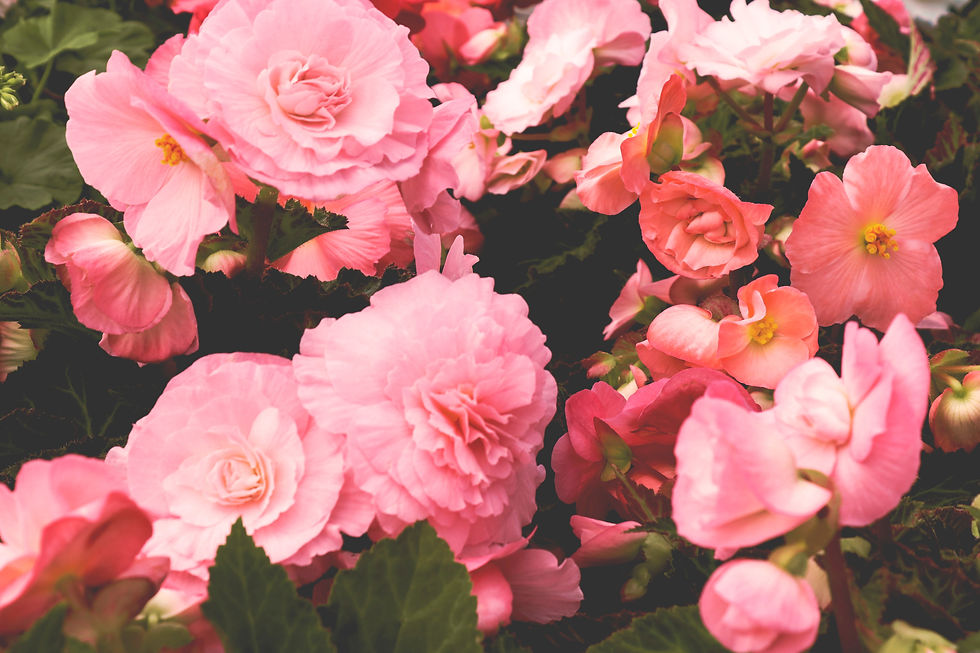Autumn Oak Lane: Begonia dreaming
- Justin Williams

- Mar 16, 2021
- 2 min read

Ode to begonias: from houseplants to outdoor hanging baskets and terrarium species, this genus of plants has thousands of species to pick from and thousands of cultivars to select and hybridize on your own time.
A cultivar is a specially bred variegation of a plant. For instance, you may have a green-leafed begonia and you want to cross it with an orange streaked-leaf begonia. The resulting seed pod of this will have several seedlings that will produce different specimens. One may be compact and form a mound and have all orange leaves, another may be leggy in growth and have green streaked leaves while being drowned in orange hues, the list goes on and on.
Now for the houseplant enthusiast, you will need a humidifier to keep these moisture-loving plants looking spazzy in your cozy humble abode. They are tender perennials which means they need to be kept warm in order to live year-round. Some begonias are called rhizomatous which means they creep along the soil bed by a modified stem sending out leaves asymmetrically. Others have fibrous roots that grow bamboo-like canes with asymmetrical leaves off-shooting from the stem, and others have cane-like growth and grow from each leaf node. There are thousands of houseplant-suitable species to collect. They come in all shades and markings from orange starbursts to purple and grey spirals. Their leaves can be star-shaped, oblong or angel wing-shaped. They like to be grown in WELL-drained soil and like to dry out between watering.
Now, for the hanging basket begonias grown outside, these are usually tuberous or cane angel wing begonias. The tuberous ones have showy flowers that mimic the peony blooms and the angel wing varieties are grown because their leaves are very harmonious. With red undersides mimicking the Louboutin heel, these plants are incredibly beautiful for showing off in entryways or backyard trees so that they cascade down from above.
The angel wing begonias can be solid-colored or have polka-dotted or frilled leaves, amping up their display. Fertilize once a month from January to May and then every other week from May to September. Let them go dormant in the winter so they can focus on sending out roots and storing energy to keep growing next year.
My favorite begonias to grow so far are probably the angel wing ones. They are so beautiful and very vigorous growers and are easy to propagate and collect more of when taking cuttings. I hope this blog inspires you to do some research and perhaps become a plant parent.








谷歌蜘蛛池搭建
谷歌快排
谷歌外链代发
谷歌留痕
谷歌蜘蛛池出租
谷歌快速排名
海外引流渠道
Telegram搜索引擎排名
巴西引流软件
谷歌霸屏技术
谷歌外推软件
四方支付系统
四方支付源码系统
四方支付系统源码
四方支付程序
四方支付平台源码
四方支付系统搭建
四方支付程序
四方支付平台搭建
四方支付系统源码
四方支付系统
四方支付系统
谷歌蜘蛛池搭建
go语言四方支付
四方支付系统源码2025
美国毕业证办理
四方支付
四方支付系统
国外毕业证书
办理美国毕业证书
美国留信认证
美国毕业证书
购买美国毕业证
美国留信认证
真实留信认证
留信认证
毕业证成绩单办理
购买美国留信认证
办理英国毕业证书
英国毕业证购买
英国毕业证书成绩单
订购英国学位证书
制作英国毕业证书
购买英国学位证书
英国文凭等级划分
定制英国毕业证书
补办英国毕业证
英国毕业证购买
BCH Miner BCH Miner
BCH Miner BCH Miner
BCH Miner BCH Miner
BCH Miner BCH Miner
BCH Miner BCH Miner
BCH Miner BCH Miner
BCH Miner BCH Miner
BCH Miner BCH Miner
BCH Miner BCH Miner
BCH Miner BCH Miner
BCH Miner BCH Miner
BCH Miner BCH Miner
BCH Miner BCH Miner
CESUR Mining CESUR Mining
stainless steel sheet stainless steel sheet
AV在线看 AV在线看;
自拍流出 自拍流出;
国产视频 国产视频;
日本无码 日本无码;
动漫肉番 动漫肉番;
吃瓜专区 吃瓜专区;
SM调教 SM调教;
ASMR ASMR;
国产探花 国产探花;
强奸乱伦 强奸乱伦;
AV在线看 AV在线看;
自拍流出 自拍流出;
国产视频 国产视频;
日本无码 日本无码;
动漫肉番 动漫肉番;
吃瓜专区 吃瓜专区;
SM调教 SM调教;
ASMR ASMR;
国产探花 国产探花;
强奸乱伦 强奸乱伦;
AV在线看 AV在线看;
自拍流出 自拍流出;
国产视频 国产视频;
日本无码 日本无码;
动漫肉番 动漫肉番;
吃瓜专区 吃瓜专区;
SM调教 SM调教;
ASMR ASMR;
国产探花 国产探花;
强奸乱伦 强奸乱伦;